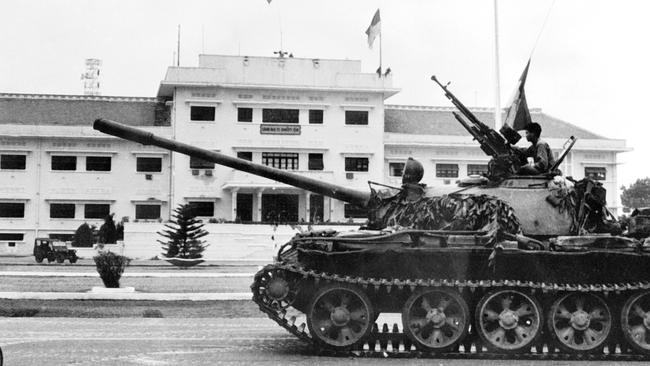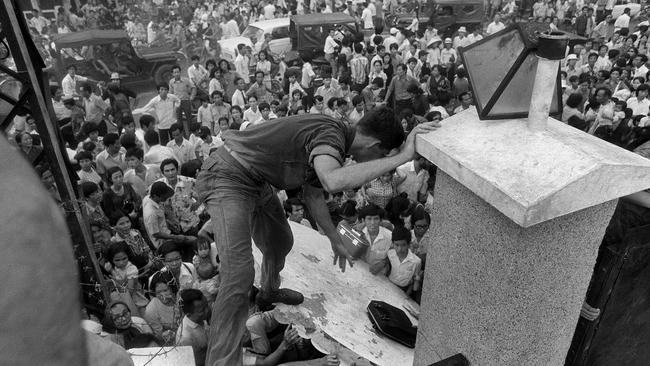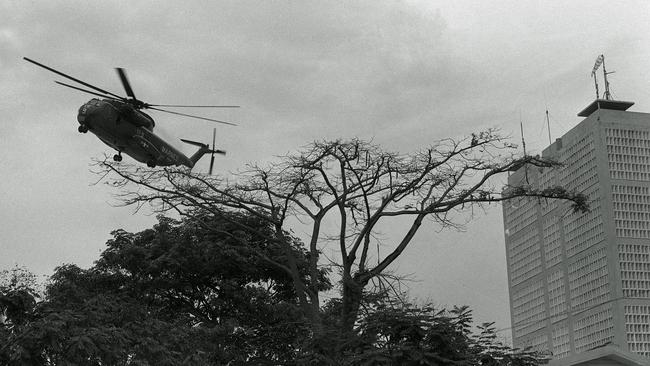Vietnam War: Scramble to escape as North Vietnamese entered Saigon
NORTH Vietnamese Communist forces had encircled Saigon as Vietnamese war orphans airlifted to Australia 40 years ago were escorted from Sydney to new homes across Australia.

Today in History
Don't miss out on the headlines from Today in History. Followed categories will be added to My News.
NORTH Vietnamese Communist forces encircled Saigon as Vietnamese war orphans, airlifted to Australia 40 years ago, were escorted from Sydney to new homes across the country. In Saigon, thousands of distraught South Vietnamese queued at the US embassy as Chinook helicopters evacuated fleeing diplomats and American citizens.
Although it had loomed for months, the taking of Saigon as the North Vietnamese Army arrived in the city to capture the presidential palace on April 30, 1975, was surprisingly rapid, easy and peaceful.
Australian and US military supporters of the South Vietnamese government had feared a bloodthirsty revenge as Communist troops arrived to claim victory after 30 years of conflict in Indochina.

But hours after the last American flags were pulled down, 20 tanks flying red-and-blue, gold-starred Vietcong flags rolled through traffic in central Saigon at 11.30am to the grounds of the Presidential Palace.
Anyone stopping to ask if they could move about freely were assured “yes” and waved on with a smile by National Liberation Front troops, many just teenagers, who moved through at 1pm with loud hailers to declare, “the forces of the National Liberation Front have become masters of Saigon. Do not worry. You will be well treated”. South Vietnamese president Duong Van Minh, who had been in office just three days, first announced South Vietnam’s unconditional surrender to North Vietnamese forces in a radio broadcast.
Asking his forces to lay down their arms, he called on the North Vietnamese Army and Viet Cong to halt all hostilities. In an appeal to Communist forces half an hour later as they met at the Presidential Palace, he said: “We are here to hand over to you the power in order to avoid bloodshed”.
North Vietnamese officer Colonel Bui Tin replied: “There is no question of your transferring power. Your power has crumbled. You cannot give up what you do not have”.

Variously known as Gia Dinh, Chu Han and Prey Nokor, Saigon was an important Khmer port on the Mekong River before it was annexed by the Vietnamese in the 17th century.
As Saigon, it became capital of the French colony Cochinchina, which crumbled when Vietnam’s Communist Party leader Ho Chi Minh declared independence in September 1945. France, which installed former emperor Bao Dai as head of state, refused to accept the declaration, leading to an eight-year war that ended with French defeat in 1954.
The subsequent Geneva Accord peace settlement divided the country. The North was under communist Ho Chi Minh, and the South led by president Ngo Dinh Diem, who deposed Bao Dai to proclaim the Republic of Vietnam in October 1955. The Geneva Accord also called for a reunification election in 1956. Diem argued that North Vietnamese people could not vote freely and refused to participate, winning backing from the US in his stance against Communism.
Aiming to overthrow Diem and reunite the country under communist rule, in 1960 North Vietnam began a guerilla campaign across the South, proclaimed as the National Front for the Liberation of South Vietnam. Committed to limiting the spread of communism in South East Asia, by 1962 more than 11,000 US military advisers were in South Vietnam. Supporting the US, Australia’s military presence began in July 1962.
As war escalated, Saigon experienced direct military action as part of the Tet offensive in 1968, when North Vietnamese forces briefly entered the US Embassy.
With the withdrawal of Australian troops in 1972 and US forces a year later, South Vietnam troops struggled to hold out against the North Vietnamese. Civilian and military casualties across Vietnam had reached up to 2 million people when more than 100,000 North Vietnamese troops encircled Saigon in April 1975.
In the two weeks before the city fell, America evacuated about 55,000 people, bringing total evacuations to about 100,000. Reports from Singapore said ships in the South China Sea continued to pick up refugees fleeing in boats down the river.
Under Operation Babylift on April 4 and 17, 1975, Australia joined Canada, France and the US to evacuate Vietnamese orphans. RAAF flights evacuated some 270 babies and children to Bangkok, for transfer to Australia by Qantas.
Originally published as Vietnam War: Scramble to escape as North Vietnamese entered Saigon


